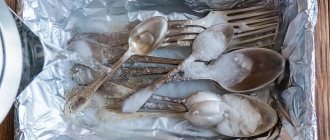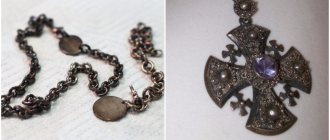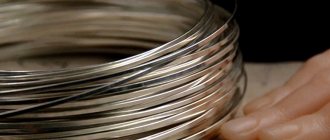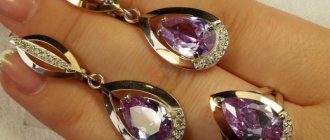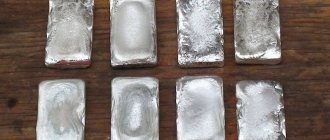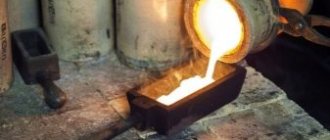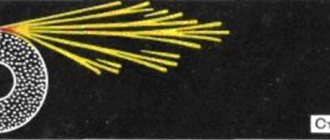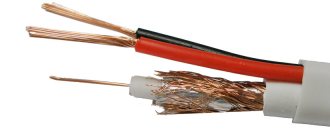Not every family can boast of having silver cutlery, and there are very few owners of complete sets. It would seem that silver is not a very expensive metal - a simple ring can be purchased for only a thousand rubles.
Why is silverware so expensive? And you count how much precious metal it takes to make one silver spoon. Plus work, a brand and other extras - a substantial amount accumulates.
Therefore, often the desire to determine the authenticity of silver spoons is not a whim, but a matter of prestige, the feasibility of financial investments and the characteristics of care. Especially if we are talking about family or any other rare silver.
Cupronickel as an imitation of silver
Cupronickel has a lot in common with silver in appearance.
Silver is a precious, expensive metal, from which not only dishes were made, but also jewelry, coins, and figurines. Silver is often replaced with similar and inexpensive cupronickel. That is why it is important to distinguish cupronickel from silver in a store, market, souvenir shop or at home.
Cupronickel is an alloy of copper, nickel and zinc. Outwardly, cupronickel is very similar to silver, which is what many take advantage of by selling counterfeits of cupronickel under the guise of this precious metal. In everyday life, there may be difficulties in solving the problem of distinguishing nickel silver products from silver products.
Historically, cupronickel has been a good imitation of silver. The color of such an alloy depends on the percentage of copper in its composition and can vary from yellowish to red-yellow shades. Manganese and iron are added to make the material resistant to corrosion. Cupronickel products have a pleasant silvery sheen.
Cupronickel is traditionally used to create dishes and jewelry that perfectly imitate silver items. It often happens that people try to pass off nickel silver items as silver.
Cupronickel silver products are often coated with silver. Cupronickel silver-plated cutlery and crockery look like real silverware. Therefore, when buying silver jewelry and cutlery, we need to look very carefully at what we are buying.
In order not to buy a cheap fake cupronickel alloy, you need to use simple methods that allow you to quickly find cupronickel.
Identifying real metal
To understand how to distinguish silver from other metals, you need to clearly understand the main characteristics of the imitations that are so often passed off as silver. It becomes clear that modern jewelry factories and industrial factories conduct careful control and do not allow silver of dubious quality to enter the market. They all work in accordance with certain standards and GOSTs, so you don’t have to worry about quality when purchasing silver products from reliable places and trusted jewelry stores.
Cupronickel alloys
Cupronickel alloys can have different percentage compositions of substances. The most popular cupronickel alloy contains from 5 to 30 percent nickel, with the remaining percentages being iron (0.8 percent) and manganese (0.1 percent).
There are other alloys that are very similar in their chemical composition to cupronickel, but have different names:
- Cupronickel contains only copper and nickel in equal proportions;
- Monel, contains up to 67 percent nickel;
- nickel silver, contains additional zinc;
- Constantan contains 55 percent copper and 45 percent nickel.
Cupronickel products are easily soldered and polished. In the manufacture of cupronickel products, special solders based on tin-lead or silver alloys can be used. Cupronickel is well processed, alloyed with other metals, cut, forged, embossed, stamped, polished and soldered. Such properties of cupronickel make it possible to effectively use it to replace natural silver.
The attractive appearance has allowed the copper alloy to occupy a stable niche in jewelry, no longer for counterfeiting silver items, but as an independent alloy.
Story
The Chinese were the first to obtain nickel silver from metals back in the 3rd century BC. But the alchemists of the Celestial Empire did not discover the secret of “white copper”.
Europeans unraveled the secret two millennia later:
- The French Maillot and Chaurier received the alloy by 1819.
- According to their authentic spelling – Maillot + Chorier – the alloy was christened.
- However, the term entered history modified: the Melchior variant seemed more harmonious to the Germans, and then to other peoples.
Melchior was the name of one of the trinity of wise men who came with gifts to the newborn baby Christ.
- In Russia (USSR), the term took hold by the 1930s, displacing the “German composition”, “serebrovid” and other variants.
- In Europe the term Cupronickel is in circulation.
An alloy that resembles a noble metal in description is also called Nickel silver, German silver, New silver (nickel, German, new silver).
Ten reliable ways to distinguish cupronickel from silver
10 ways to distinguish cupronickel from silver:
- the abbreviation MNC (an alloy of copper, nickel and zinc) indicates that it is cupronickel;
- Cupronickel silver becomes covered with a green coating when left in the water for a long time;
- the action of the lapis pencil will not change the silver, but a dark spot will appear on the cupronickel;
- you can use weighing - cupronickel is lighter than silver;
- cupronickel has the smell of copper;
- silver darkens when exposed to iodine solution in the sun;
- reaction to nitric acid - silver will darken, and the copper alloy will give a green tint;
- reaction to chalk - silver darkens, cupronickel does not change color;
- the action of a magnet, silver is not magnetic, and cupronickel may have weak magnetic properties (depending on the composition of the metals);
- the effect of oxidation - silver cannot have traces of rust; if there are any, it is definitely not silver.
If the product is made of nickel silver and then coated with a thin layer of silver, then in order to find a fake it will be enough to scratch it with a thin tool in an inconspicuous place. If the color in the depth of the product is different, then cupronickel or even cheaper metal was probably used.
Another simple (but not accurate) method is to heat the product being tested, for example, by rubbing it on your hand; silver has high thermal conductivity and will heat up much faster than cupronickel.
Use the methods described in our article to easily distinguish cupronickel from silver, and enjoy a successful purchase!
Iodine
You can check the authenticity with another means available at any pharmacy, namely iodine. Cupronickel and other metals do not change their appearance under the influence of iodine; low-quality silver, with a large percentage of zinc impurities, will change its color to blue, but real silver, as soon as iodine is dropped on it, will turn black. But this method is also undesirable for those who do not know how to clean silver. But don’t despair, there’s plenty of advice on the Internet on how to do this. The most reliable way is to use a special cleaning cloth or silver cleaning solution.
Secrets of transmutation
In all centuries, scientists, not only chemists, but also physicists, as well as medieval alchemists, struggled with the question: is it even possible to scientifically obtain another metal similar to gold? Atomic scientists have proven that at the atomic level, one metal can acquire the properties of another through the transmutation of chemical elements located next to each other on the periodic table (for example, mercury and platinum can, as a result of a reaction, transform into stable gold).
By the way, this is one of the very first and most reliable ways to obtain gold from metal. Back in the Middle Ages, alchemists cheated like this in front of kings and emperors. Gold powder dissolved in mercury, then the mercury evaporated and a gold bar remained.
All other ways to obtain gold by manipulating various metals (iron, tin, lead) can only lead to the production of an alloy with a small admixture of gold. Most often, this is exactly what scammers achieve, whose main task is to make the fake as high quality as possible.
Some scientist even jokingly summed up the “scientific” basis for the similarity of bronze to gold. He said that if you add up the charges of the nuclei of the alloy components (29 for copper and 50 for tin), you will certainly get “gold”.
However, in order not to get into trouble when buying real gold jewelry, it is advisable to know what alloys form a metal similar to gold. Although even experts cannot always distinguish a fake, especially if gold is actually added to the alloy. In this case, they say that this is gold of a very low standard. .
Designations
| Name | Meaning |
| Designation GOST Cyrillic | MNC15-20 |
| Designation GOST Latin | MHTs15-20 |
| Translit | MNTs15-20 |
| By chemical elements | CuNiZn15-20 |
| Name | Meaning |
| Designation GOST Cyrillic | Nickel silver |
| Designation GOST Latin | Heizilbep |
| Translit | Neuzilber |
| By chemical elements | Nieuilsilver |
Sample and touchstone
Modern rules that form the basis for the circulation of precious metals make it possible to distinguish copper and other additives from silver, as well as determine their content in a product. For this purpose, a measure has been established, the so-called test. And to monitor compliance with the rules, special devices have been invented.
You need to know about the sample system and the rules for their use:
- The sample shows how much Ag is contained in the alloy. It represents a three-digit number. Conventionally, each unit here means 1 gram in 1 kilogram. But kilogram jewelry is a thing of the past. Therefore, the measuring unit on modern products simply shows every tenth of a percent of argentum.
- When making jewelry, 925 alloys are most often used. This means that they contain 92.5% Ag and 7.5% copper.
- Less common hallmarks: 750, 800, 875, 916, 960. 999 alloy (almost pure precious metal) is used only for specialty bars, high-value collectible coins and in some high-precision fields of science.
- If a product claims to be called silver, the purity must be indicated on it. It is applied by branding. Information about it is also indicated on the attached product label. The label fastening must be sealed. If the seller does not comply with these mandatory, legally established conditions, there is a high chance of encountering a counterfeit.
- In addition to the sample, the label must contain other information about the decoration. This is its name, weight, total price and price per 1 gram, name of the manufacturer, description of the stones (if any). If the product is plated (for example, rhodium), this must also be indicated.
- Information about the name, weight, sample, and price of the product must also be included in the purchase receipt.
- You can test the product for samples and additives using a touchstone. To do this, you will need to make a scratch on the jewelry and drip the reagent. Brown color, for example, will indicate the presence of brass. The yellow color will help distinguish silver from tin (lead will also signal its presence with yellow).
You can purchase the stone at a jewelry store. It should come along with a plate from which, depending on the reaction of the alloy, its composition can be accurately calculated. Now good stones are offered at prices ranging from 700-800 rubles.
Russia, of course, is not Latin America, whose countries are world leaders in argentum production. But there is also enough silver in the state. Citizens do not encounter counterfeits very often. To avoid them, as a rule, it is enough to purchase jewelry in specialized stores , and not at market stalls or station stalls.
Pricing
The cost of cupronickel alloys is determined based on the quotations of copper and nickel on world non-ferrous metals exchanges. Basically, scrap metal collection points are oriented towards the London Stock Exchange.
The most valuable are cupronickel, which has a higher nickel content in its composition. This is due to its high cost.
Particular attention should be paid to the condition of the surface when handing over nickel silver scrap. Traces from rust removal, and even more so its presence, greatly reduces the cost of scrap in the non-ferrous metals market.
The form of rental is also important. The cupronickel circle is considered the most valuable, because with the same weight, the cupronickel pipe takes up more space during transportation. Accordingly, the costs of collection points for moving scrap metal increase.
The volume of supplies also affects the cost indicator. As a rule, metal collectors make a markup when working with cupronickel scrap over 50 kilograms. This happens due to the reduction in time for selling products: the more scrap, the faster it can be sent for processing.
Cupronickel costs less than pure metals. The reason for this is the high cost of processing: separating the original components from each other. As of October 2022, the average price for cupronickel per gram in Russia is 0.2 rubles.
Application area
For the manufacture of kitchen utensils and decorative accessories, an alloy marked MH25 is used. In addition, instruments and equipment for medical purposes (clamps, ophthalmoscopes, scalpels, tweezers, etc.) are produced on the basis of cupronickel. In spoons, knives and forks, the alloy additionally includes zinc. Material with the addition of manganese is often used in the manufacture of coins.
Coatings based on a copper-nickel alloy are often used to equip automotive parts and mechanisms that require reliable and durable protection against corrosion. Alloys are also used in units and components of marine transport. Cupronickel silver is used to produce fittings, shut-off valves and pipelines.
In electrical engineering, the alloy is used for the manufacture of thermogenerators and precision resistors. Constantan (a type of cupronickel) is used in the assembly of rheostats for heating elements of electric furnaces, extension wires and thermocouples.
